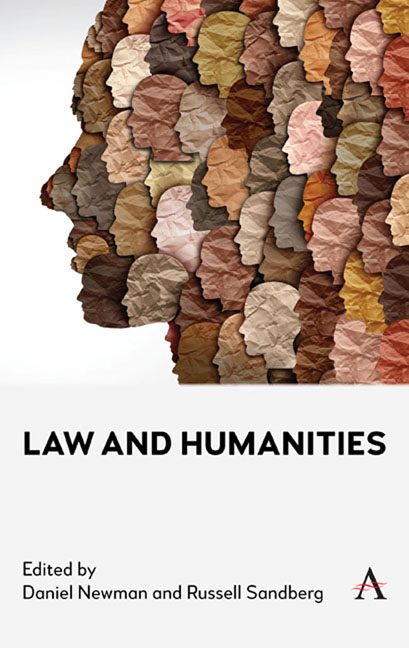Book contents
- Frontmatter
- Contents
- Preface
- List of Contributors
- Chapter One Introducing Law and Humanities
- Chapter Two Law and Archaeology
- Chapter Three Law and Comics/Graphic Justice
- Chapter Four Law and Film
- Chapter Five Law and Geography
- Chapter Six Law and History
- Chapter Seven Law and Literature
- Chapter Eight Law and Philosophy
- Chapter Nine Law and Popular Music
- Chapter Ten Law and Religion
- Chapter Eleven Law and Television
- Chapter Twelve Law and Theatre
- Chapter Thirteen Law and Theology
- Chapter Fourteen Law and Video Games
- Chapter Fifteen Conclusion: Subverting the Law and Humanities Canon
- Index
Preface
Published online by Cambridge University Press: 27 March 2024
- Frontmatter
- Contents
- Preface
- List of Contributors
- Chapter One Introducing Law and Humanities
- Chapter Two Law and Archaeology
- Chapter Three Law and Comics/Graphic Justice
- Chapter Four Law and Film
- Chapter Five Law and Geography
- Chapter Six Law and History
- Chapter Seven Law and Literature
- Chapter Eight Law and Philosophy
- Chapter Nine Law and Popular Music
- Chapter Ten Law and Religion
- Chapter Eleven Law and Television
- Chapter Twelve Law and Theatre
- Chapter Thirteen Law and Theology
- Chapter Fourteen Law and Video Games
- Chapter Fifteen Conclusion: Subverting the Law and Humanities Canon
- Index
Summary
Interdisciplinary approaches to law are now commonplace at least in terms of legal research. Although in the Anglo-American world at least such work has tended to be predominantly social scientific in focus, there has also been an increase in interdisciplinary scholarship on law that draws upon the humanities. This is most notable in the large literature on law and literature as well as the development of a number of further ‘law and’ fields. Some of these (e.g. law and history, law and religion, law and philosophy) have been long-lasting but have been revived in recent years by increased interdisciplinary collaborations while other areas (e.g. law and television, law and comics, law and music) represent new areas of interest that have seen legal scholars interact with academics from other parts of the university and with practitioners, artists and producers. These ‘law and’ fields, however, tend to exist in isolation from one another and this limits their development in that they are not able to draw upon each other’s intellectual and methodological developments and because this means that they exist as small disparate fields at the margins of law as an academic discipline.
There is now a growing number of works that pay attention to ‘law and humanities’ as a field, including a small number of specialist journals, but these typically take a thematic approach and are not particularly accessible to newcomers and to a student readership. This edited work, therefore, fulfils a real and pressing need to provide an accessible, introductory but critical guide to law and humanities as a whole by exploring how various disciplinary ‘law and’ fields have developed. Law and Humanities contributes to further scrutinising the content and role of law, and how it can contribute and be enriched by being understood within the law and humanities tradition as a whole.
This edited collection provides an accessible introduction to law and humanities. It is designed to be the first port of call for students and scholars interested in particular ‘law and’ fields and law and humanities in general. It examines a number of ‘law and’ interactions in turn (ordered alphabetically). Each chapter is written by an expert in the respective field and will explore the nature, development and possible further trajec-tory of that particular disciplinary ‘law and’ field. As editors, we have encouraged each contributor to conceptualise their own discussion of their field.
- Type
- Chapter
- Information
- Law and Humanities , pp. vii - viiiPublisher: Anthem PressPrint publication year: 2024

